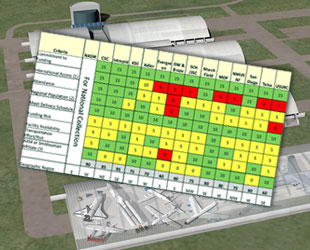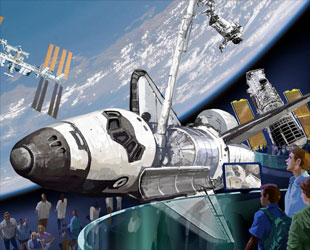August 27, 2011 — NASA's selection of display locations for retired space shuttles in California, Florida, New York and Virginia was implemented fairly and without improper influence, federal investigators reported Aug. 25.
NASA's Office of Inspector General (OIG), which provides independent oversight for the agency, reviewed NASA's selection process as a result of concerns being raised by politicians and by some of the museums who missed out on receiving one of the four prized orbiters for their state or facility.
"Disappointed applicants and some members of Congress questioned whether the agency's selection process had complied with federal law or was influenced by improper political considerations," OIG investigative counsel James Mitzelfeld said in a video released with the 26-page report. "To answer these questions, [OIG] examined the agency's process for choosing permanent display locations for the shuttle orbiters."
NASA Administrator Charles Bolden, who made the final decision where the orbiters would go after being advised by an internal recommendation team, announced on April 12, 2011 that space shuttle Discovery would be going on display at the Smithsonian's Steven F. Udvar-Hazy Center in northern Virginia, Endeavour would go to the California Science Center in Los Angeles, and Atlantis would be exhibited by the Kennedy Space Center Visitor Complex in Florida.
Furthermore, the prototype orbiter Enterprise, which was transferred to the Smithsonian in 1985 and displayed at the Udvar-Hazy since 2003, would go to the Intrepid Sea, Air and Space Museum in New York City.
According to Bolden, who was interviewed by the OIG as part of their review, his choice of museums was guided by which of the locations could "provide the greatest number of people with the best opportunity to share in the history and accomplishments of NASA's remarkable space shuttle program."
Congress however, had passed legislation directing NASA to take into consideration additional factors, including an "historical relationship" with the space shuttle orbiters or human spaceflight. As a result, questions arose if politics dictated the chosen locations.
Acknowledging errors in the evaluation process, the OIG found that such concerns were without merit.
"We found no evidence that the White House, politics, or any other outside force improperly influenced the selection decision," Mitzelfeld said.
Scoring the shuttle suitors
By the time Bolden became Administrator in July 2009, NASA had already formed a recommendation team and received an initial response from museums and science centers interested in displaying a space shuttle. Working on their own, the team — led by Olga Dominguez, the assistant administrator for NASA's Office of Strategic Infrastructure — had developed five possible options for placing the orbiters, which they later presented to Bolden.
Under all five of the team's options, one orbiter would be placed at the Smithsonian. For the other three shuttles, options included restricting them to government facilities only, such as the Kennedy Visitor Complex, Space Center Houston in Texas, and the National Museum of the U.S. Air Force in Ohio, or favoring geographic diversity, placing orbiters in Florida, Texas and Washington state.
The team's preferred option at the time was to display the orbiters at NASA visitor centers, specifically Endeavour at the Kennedy Visitor Complex, Atlantis at Space Center Houston, and Enterprise at the U.S Space and Rocket Center in Alabama.
Bolden however, favored placing a greater emphasis on reaching the largest number of visitors, which led the team to reconsider the suitors and, after soliciting another round of interested museums in January 2010, began the process of ranking the 13 eligible institutions by its set of nine criteria.
The team awarded points for museum attendance levels, regional population, access for international visitors, and museum certification. The team also factored in logistical considerations, including the risk associated with moving the orbiter to the display location, the availability of an appropriate exhibit facility and the ability for each museum to reimburse NASA the $28.8 million it would cost to prepare and transport the shuttles for display.
According to the OIG's report, the three institutions that received the highest point totals were the Intrepid Sea, Air and Space Museum, the California Science Center and the Kennedy Space Center Visitor Complex, where Bolden ultimately awarded orbiters.

A "significant error" in NASA's scoring matrix discounted the National Museum of the U.S. Air Force in Ohio. (NMUSAF/OIG) |
In reviewing the team's calculations however, the OIG found that the scoring including a "significant error." The Air Force Museum was ranked lower than it should have been for the risk associated with delivering a shuttle to the Dayton, Ohio institution.
"Team members said that they had consistently rated the [Air Force Museum] a low risk for the anticipated difficulty of transporting an orbiter because the airport was just five miles away on an adjacent property," the OIG wrote in the report. "The team attributed the mistake, which they said was unintentional, to a 'cut and paste' error."
Had the mistake not been made, it would have resulted in their being a three-way tie between the Air Force Museum, the Intrepid and Kennedy Visitor Complex. Bolden told the OIG had he been informed of a tie he would have made the same decision.
"He said this was because the Air Force Museum was unable to commit to raising the $28.8 million required to reimburse NASA for an orbiter and because the Intrepid and the Kennedy Visitor Complex had larger regional populations and better access for international visitors," the report reads. "He noted that during his travels as Administrator he had visited many of the top-scoring institutions and that in addition to the information provided by the team, he relied on his own subjective view of the sites' strengths and weaknesses to reassure himself that he was making the correct decision."
Display plans detailed
In addition to reviewing the selection process, the OIG also provided in its report new insight into how and when the selected museums plan to receive and display the orbiters.
As earlier released by NASA, space shuttle Discovery will be the first to be delivered, with a targeted April 12, 2012 arrival at Dulles International Airport outside Washington atop one of NASA's modified-Boeing 747 shuttle carrier aircraft. The Smithsonian will display Discovery where Enterprise is exhibited now at the Steven F. Udvar-Hazy Center, which serves as the annex to the institution's National Air and Space Museum.
Within a few days of Discovery's arrival, Enterprise will be flown to the John F. Kennedy International Airport (JFK) in New York City, where it will be stored in a temporary, climate-controlled tent with limited public viewing through March 2014. The prototype orbiter will then be barged to the Intrepid, where the aircraft carrier-turned-museum will have ready its new display facility for Enterprise.
Endeavour will be ferried to the Los Angeles International Airport (LAX) in June 2012, where it will be transferred using a refurbished "overland transporter" to a temporary display facility located adjacent to the California Science Center 15 miles away. The Center plans its permanent facility to open in 2016, where Endeavour will be exhibited in a vertical position, as if poised on its launch pad.

An artist rendition of Kennedy Space Center's plans for a $100 million, 64,000 sq. foot exhibit for space shuttle Atlantis. (KSCVC) |
Atlantis, having flown the final space shuttle mission last month, will be prepared for display and then stored inside NASA's 52-story Vehicle Assembly Building (VAB), where the Kennedy Space Center Visitor Complex will bus tour groups through February 2013. Atlantis will then be moved to its new facility on the grounds of the Visitor Complex, where the orbiter will be displayed in a tilted, horizontal position as if in orbit around the Earth.
